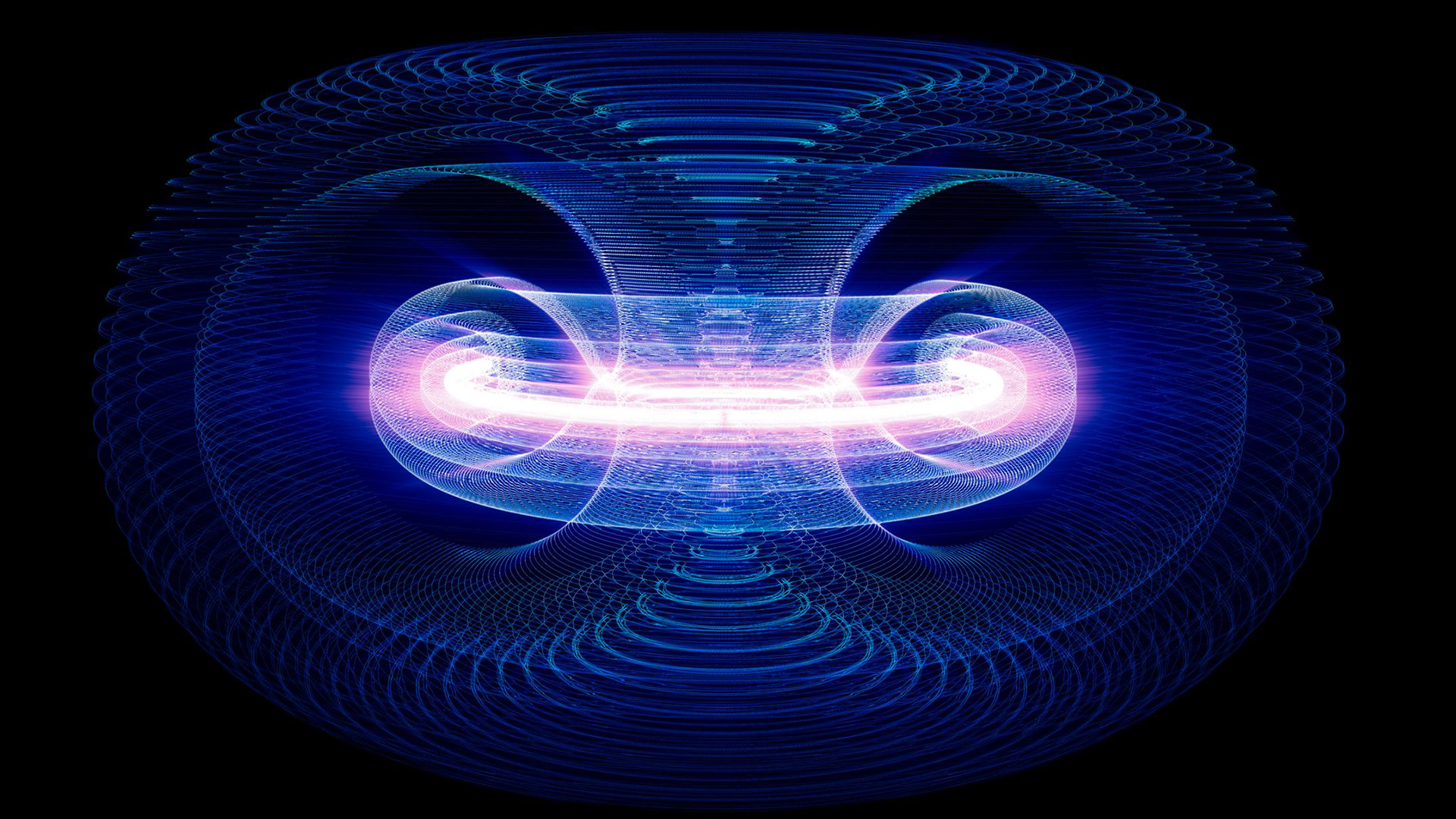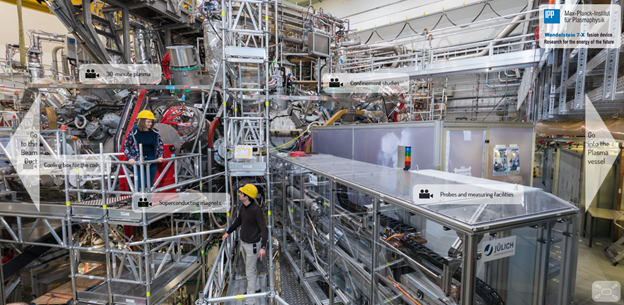This large-bore, full-scale high-temperature superconducting magnet designed and built by Commonwealth Fusion Systems and MIT’s Plasma Science and Fusion Center is the strongest fusion magnet in the world. (Photo: Gretchen Ertl, CFS/MIT-PSFC)
A high-temperature superconducting magnet reached and maintained a magnetic field of more than 20 tesla in steady state for about five hours on September 5 at MIT’s Plasma Science and Fusion Center. Not only is the magnet the strongest high-temperature superconducting (HTS) magnet in the world by far, it is also large enough—when assembled in a ring of 17 identical magnets and surrounding structures—to contain a plasma that MIT and Commonwealth Fusion Systems (CFS) hope will produce net energy in a compact tokamak device called SPARC in 2025, on track for commercial fusion energy in the early 2030s.
Taken from above, this photo of the subassembly tool shows the complex system of alignment units used to slowly swing two toroidal field coils (bottom left and right) into position around the vacuum vessel sector. In the background, poloidal field coil #5 sits on the floor of the Assembly Hall, awaiting installation in the assembly pit in mid-September. (Photo: ITER)
Inside the ITER Assembly Hall, aided by a 20-meter-tall sector subassembly tool known as SSAT-2, the first of nine 40-degree wedge-shaped subassemblies that will make up the device’s tokamak is taking shape. On August 30, the ITER Organization announced that all the components of the first subassembly were in place on the SSAT-2. After the wings of the subassembly tool slowly close, locking two vertical coils in place around the outside of a vacuum vessel section that is already wrapped in thermal shielding, the completed subassembly will be ready for positioning in the ITER assembly pit in late October.
A color-enhanced photograph of the NIF target bay. (Photo: LLNL/Damien Jemison)
Lawrence Livermore National Laboratory is celebrating the yield from an experiment at the National Ignition Facility (NIF) of more than 1.3 megajoules of energy—eight times more than the yield from experiments conducted this spring and 25 times more than NIF’s 2018 record yield.
The magnet system of Wendelstein 7-X features 50 superconducting magnet coils. (Graphic: IPP)
The Max Planck Institute for Plasma Physics (IPP) was founded in Garching, Germany, in 1960, the same year that its Wendelstein 1a stellarator began operation. Wendelstein 7-X is now operating at IPP’s site in Greifswald, Germany, and one of the objectives the device was designed to achieve has recently been confirmed, IPP announced on August 12. Analysis by IPP scientists shows that the twisted magnetic coils of the device successfully control plasma energy losses, indicating that stellarator fusion devices could be suitable for power plants, according to a detailed analysis of experimental results published on August 11 in Nature.
ITER CS Module 1 (shown here at right with the General Atomics fabrication team) is being loaded onto a specialized heavy transport vehicle for shipment to Houston, Texas, where it will be placed on a ship for transit to France. (Photo: General Atomics)
After a decade of design and fabrication, General Atomics (GA) is preparing to ship the first module of the central solenoid—the largest of ITER’s magnets—to the site in southern France where 35 partner countries are collaborating to build the world’s largest tokamak and the first fusion device to produce net energy.
The Max Planck Institute for Plasma Physics offers an interactive and informative 360-degree panoramic tour of Wendelstein 7-X. (Source: ipp.mpg.de)
U.S. scientists are getting funding to carry out seven research projects at two major stellarator fusion energy facilities located in Germany and Japan, the Department of Energy announced on June 8. A total of $6.4 million has been allocated for seven research projects with terms of up to three years.
ORNL associate laboratory director Kathy McCarthy at the prototype which led to the Material Plasma Exposure eXperiment (MPEX), a device that will support fusion materials research. Photo: ORNL
Oak Ridge National Laboratory has a long record of advancing fusion and fission science and technology. Today, the lab is focused more than ever on taking advantage of that spectrum of nuclear experience to accelerate a viable path to fusion energy and to speed efficient deployment of advanced nuclear technologies to today’s power plants and future fission systems.
Plasma in MAST. (Photo: UKAEA/EUROfusion)
As governments around the world cooperate on the ITER tokamak and, in parallel, race each other and private companies to develop commercial fusion power concepts, it seems that “game-changing” developments are proclaimed almost weekly. Recently, the United Kingdom and China announced new fusion program results.
Photo: NASA, ESA, and STScI
First Light Fusion CEO Nick Hawker stands near the target end of the 22-meter-long gas gun. (Photo: First Light)
Inside a new steel-clad facility nicknamed “The Citadel,” First Light Fusion has installed a 22-meter two-stage gas gun—the third-largest such component in Europe.
Former NASA astronaut Franklin R. Chang-Diaz talks about the ways nuclear fusion will assist in deep space travel. (Photo: Navigating Nuclear)
Construction of Norman was completed in 2017. Photo: TAE Technologies
TAE Technologies has announced that it has produced a stable plasma of over 50 million degrees celsius inside a fusion device using a beam-driven, field-reversed configuration. “By generating such stable high-temperature plasmas, TAE has now validated that the company’s unique approach can scale to the conditions necessary for an economically viable commercial fusion power plant by the end of the decade,” the company declared in its April 8 press release. The company added that the results indicate the design’s linear configuration improves plasma confinement as temperatures rise.
In this illustration of the effects of two neutron yields (50 kt and 1 Mt) and two neutron energies (14.1 MeV and 1 MeV), the black dots represent the location of a nuclear device. Dark blue indicates where the asteroid remains solid, while all other colors show where material has been melted or vaporized. The illustration depicts asteroids with 0.8-m and 5-m diameters—much smaller than the 300-m asteroid simulated in the study—to enhance the visibility of the area of the energy deposition. Image: LLNL
A research collaboration between Lawrence Livermore National Laboratory and the Air Force Institute of Technology (AFIT) has investigated how the neutron energy generated by the detonation of a nuclear device could affect the path and speed of an asteroid on a collision course with Earth by melting and vaporizing a portion of the asteroid. The research, which compared the deflection caused by two different neutron energies—14.1 MeV and 1 MeV, representing fusion and fission neutrons, respectively—is described in an article published by LLNL on April 8.
The outside of the DIII-D tokamak, where testing that supports the development of the Compact Advanced Tokamak has been performed. Photo: General Atomics
Scientists at the DIII-D National Fusion Facility have published research on a compact fusion reactor design they say could be used to develop a pilot-scale fusion power plant. According to General Atomics (GA), which operates DIII-D as a national user facility for the Department of Energy’s Office of Science, the Compact Advanced Tokamak (CAT) concept uses a self-sustaining configuration that can hold energy more efficiently than in typical pulsed configurations, allowing the plant to be built at a reduced scale and cost.



















